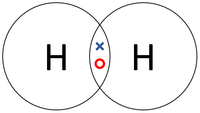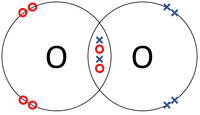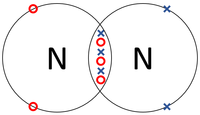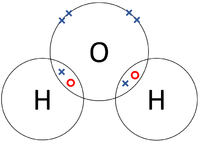Difference between revisions of "Simple Covalent Molecule"
(→Examples) |
|||
| (2 intermediate revisions by the same user not shown) | |||
| Line 6: | Line 6: | ||
: '''Simple covalent molecules''' are simple in that they have only a small number of [[atom]]s. | : '''Simple covalent molecules''' are simple in that they have only a small number of [[atom]]s. | ||
: '''Simple covalent molecules''' can be [[element]]s or [[compound]]s. | : '''Simple covalent molecules''' can be [[element]]s or [[compound]]s. | ||
| − | |||
| − | |||
: The [[Covalent Bond|covalent bonds]] in a '''simple covalent molecule''' can be represented with a [[Dot and Cross Diagram]]. | : The [[Covalent Bond|covalent bonds]] in a '''simple covalent molecule''' can be represented with a [[Dot and Cross Diagram]]. | ||
| Line 27: | Line 25: | ||
|- | |- | ||
|[[File:CarbonDioxideDotandCrossDiagram.png|center|200px]] | |[[File:CarbonDioxideDotandCrossDiagram.png|center|200px]] | ||
| − | |[[File:WaterDotandCrossDiagram.png|center| | + | |[[File:WaterDotandCrossDiagram.png|center|200px]] |
| − | |[[File:MethaneDotandCrossDiagram.png|center| | + | |[[File:MethaneDotandCrossDiagram.png|center|200px]] |
|- | |- | ||
| style="height:20px; width:200px; text-align:center;" |Each [[Oxygen]] shares two of its [[electron]]s with the [[Carbon]] [[atom]] while the [[Carbon]] [[atom]] shares two [[electron]]s with each [[Oxygen]] [[atom]]. | | style="height:20px; width:200px; text-align:center;" |Each [[Oxygen]] shares two of its [[electron]]s with the [[Carbon]] [[atom]] while the [[Carbon]] [[atom]] shares two [[electron]]s with each [[Oxygen]] [[atom]]. | ||
| − | | style="height:20px; width: | + | | style="height:20px; width:200px; text-align:center;" |Each [[Hydrogen]] [[atom]] shares its only [[electron]] with the [[Oxygen]] [[atom]] and the [[Oxygen]] shares one of its [[electron]]s with each [[Hydrogen]] [[atom]]. |
| − | | style="height:20px; width: | + | | style="height:20px; width:200px; text-align:center;" |Each [[Hydrogen]] [[atom]] shares its only [[electron]] with the [[Carbon]] [[atom]] and the [[Carbon]] [[atom]] each of its 4 [[electron]]s with the [[Hydrogen]] [[atom]]s. |
|} | |} | ||
| + | |||
| + | ===Bulk Properties=== | ||
| + | : The [[Physical Property|physical properties]] of [[substance]]s made of '''simple covalent molecules''' are determined by the the [[Covalent Bond|covalent bonds]] within [[molecule]]s and the [[Intermolecular Bond|intermolecular bonds]] between [[molecule]]s. | ||
| + | : The [[Boiling Point|boiling point]] and [[Melting Point|melting point]] of a ''simple covalent''' [[substance]] are determined by the strength of [[Intermolecular Bond|intermolecular bond]]s. The stronger the [[Intermolecular Bond|intermolecular bond]]s the higher the [[Boiling Point|boiling point]] and [[Melting Point|melting point]]. | ||
| + | : [[Substance]]s made of '''simple covalent molecules''' are usually poor [[Electrical Conductor|electrical conductors]] because [[Electrical Charge|charge]]d [[particle]]s such as [[electron]]s or [[ion]]s are not free to move from one place to another. | ||
| + | : [[Substance]]s made of '''simple covalent molecules''' are usually poor [[Thermal Conductor|thermal conductors]] because [[electron]]s are not free to move around the [[material]]. | ||
Latest revision as of 10:59, 2 February 2019
Contents
Key Stage 4
Meaning
Simple covalent molecules are small molecules in which the atoms are held together by covalent bonds.
About Simple Covalent Molecules
- Simple covalent molecules are simple in that they have only a small number of atoms.
- Simple covalent molecules can be elements or compounds.
- The covalent bonds in a simple covalent molecule can be represented with a Dot and Cross Diagram.
Examples
| The two Hydrogen atoms each share one electron with each other. | The two Oxygen atoms each share two of their electrons with one another. | The two Nitrogen atoms each share three of their electrons with one another. |
| Each Oxygen shares two of its electrons with the Carbon atom while the Carbon atom shares two electrons with each Oxygen atom. | Each Hydrogen atom shares its only electron with the Oxygen atom and the Oxygen shares one of its electrons with each Hydrogen atom. | Each Hydrogen atom shares its only electron with the Carbon atom and the Carbon atom each of its 4 electrons with the Hydrogen atoms. |
Bulk Properties
- The physical properties of substances made of simple covalent molecules are determined by the the covalent bonds within molecules and the intermolecular bonds between molecules.
- The boiling point and melting point of a simple covalent' substance are determined by the strength of intermolecular bonds. The stronger the intermolecular bonds the higher the boiling point and melting point.
- Substances made of simple covalent molecules are usually poor electrical conductors because charged particles such as electrons or ions are not free to move from one place to another.
- Substances made of simple covalent molecules are usually poor thermal conductors because electrons are not free to move around the material.





